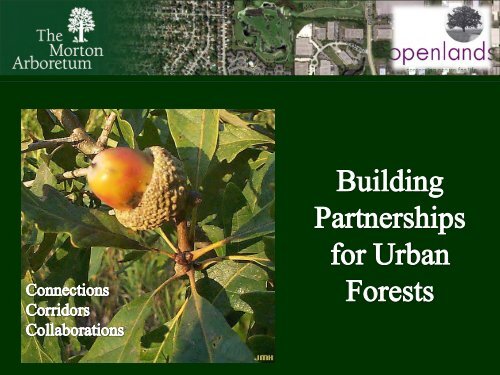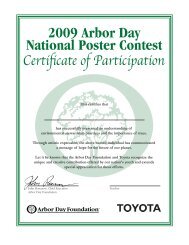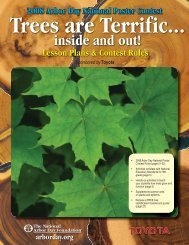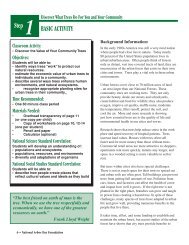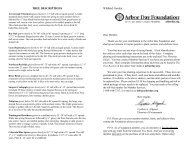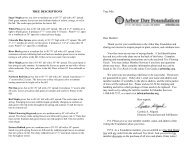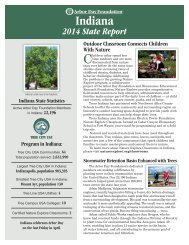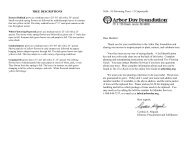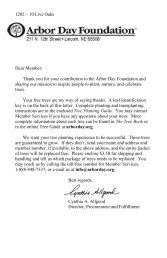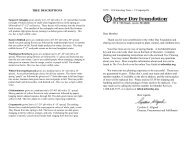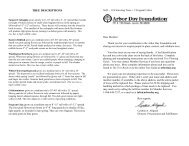Regional Tree Initiatives - Arbor Day Foundation
Regional Tree Initiatives - Arbor Day Foundation
Regional Tree Initiatives - Arbor Day Foundation
You also want an ePaper? Increase the reach of your titles
YUMPU automatically turns print PDFs into web optimized ePapers that Google loves.
Chicago <strong>Regional</strong> Forest
Openlands is a regional conservation<br />
organization, serving the metropolitan<br />
Chicago area and focused on the protection<br />
of and advocacy for green space through a<br />
variety of programs.
The Morton <strong>Arbor</strong>etum<br />
Founded in 1922<br />
1700 acres<br />
222,000 plants with 4,300 different taxa<br />
The Center for <strong>Tree</strong> Science<br />
Research and Conservation<br />
Educational Outreach<br />
Partnerships
A Community Asset<br />
All trees – whether on public or private land<br />
are part of the urban and community forest.<br />
Our trees are a community asset.<br />
It takes a “community” to protect, manage<br />
and enhance our forest.
Urban and<br />
Community Forestry<br />
a holistic approach to the management of<br />
trees and forest resources as green<br />
infrastructure in and around community<br />
ecosystems for the benefits they provide.
<strong>Tree</strong>s and forest of Chicago region are<br />
under threat:<br />
• Insects<br />
• Disease<br />
• Invasive species<br />
• Climate<br />
• Development<br />
• Changing infrastructure
<strong>Tree</strong> Census: To better understand the<br />
forest resource and its values<br />
Use the USDA Forest<br />
Service, Northern<br />
Research Station –<br />
Urban Forest Effects<br />
(UFORE) model, now<br />
known as i-<strong>Tree</strong> Eco<br />
• Forest structure<br />
• Potential risk to forest from<br />
insects or diseases<br />
• Air pollution removal<br />
• Carbon storage<br />
• Annual carbon removal<br />
(sequestration)<br />
• Changes in building energy use
<strong>Regional</strong> <strong>Tree</strong> Census:<br />
• Informs discussion of trends<br />
• Informs policy<br />
• Informs the value of tree services to<br />
constituencies who may not value trees but<br />
value their services
<strong>Regional</strong> Forest Summary (<strong>Tree</strong>s)<br />
Number of trees 157,142,000<br />
<strong>Tree</strong> and shrub cover 21.0%<br />
<strong>Tree</strong> cover 15.5%
<strong>Regional</strong> Forest Summary<br />
Most common species<br />
European buckthorn,<br />
green ash, box elder,<br />
black cherry, American elm<br />
Percentage of trees < 6” dbh 73.3%
<strong>Regional</strong> Forest Summary<br />
Pollution removal – trees 18,080 tons/yr ($205 m/yr)<br />
<strong>Tree</strong>s and shrubs 24,179 tons/yr ($274 m/yr)<br />
VOC emissions<br />
11,976 tons/yr<br />
Carbon storage<br />
16.9 million tons ($349 m/yr)<br />
Carbon sequestration 677,000 tons/yr ($14 m/yr)<br />
Building energy reduction $44 m/yr<br />
Reduced carbon emissions$1.3 m/yr<br />
Compensatory value $51.2 billion
Land Use – Chicago Region<br />
CTI<br />
14.0%<br />
Open Space<br />
23.0%<br />
Agriculture<br />
32.9%<br />
Residential<br />
30.1%<br />
CTI = Commercial/transportation/institutional
<strong>Tree</strong> Species Distribution<br />
other species<br />
41.0%<br />
European<br />
buckthorn<br />
28.2%<br />
Green ash<br />
5.5%<br />
Boxelder<br />
5.5%<br />
Northern red oak<br />
2.0%<br />
Silver maple<br />
2.0%<br />
White ash<br />
2.6%<br />
Amur honeysuckle<br />
2.1%<br />
Black cherry<br />
4.9%<br />
American elm<br />
3.4%<br />
Sugar maple<br />
2.8%
Number of <strong>Tree</strong>s by Land Use<br />
Number of <strong>Tree</strong>s (millions)<br />
90<br />
80<br />
70<br />
60<br />
50<br />
40<br />
30<br />
20<br />
10<br />
0<br />
Number of trees<br />
<strong>Tree</strong>s per acre<br />
Open Space Residential CTI Agriculture<br />
Land Use<br />
140<br />
120<br />
100<br />
80<br />
60<br />
40<br />
20<br />
0<br />
Density (trees per acre)
1,600<br />
Leaf Area by Land Use<br />
2.5<br />
Leaf Area (thousand acres)<br />
1,400<br />
1,200<br />
1,000<br />
800<br />
600<br />
400<br />
200<br />
0<br />
Leaf area<br />
Leaf area index<br />
Residential Open Space CTI Agriculture<br />
Land Use<br />
2<br />
1.5<br />
1<br />
0.5<br />
0<br />
Leaf Area Index (LAI)
50<br />
More Leaf Area on Large <strong>Tree</strong>s<br />
45<br />
40<br />
35<br />
30<br />
Percent<br />
25<br />
20<br />
15<br />
10<br />
5<br />
0<br />
Leaf area<br />
Abundance<br />
1-3 3-6 6-9 9-12 12-15 15-18 18-21 21-24 24-27 27-30 30+<br />
Diameter Class (d.b.h. in inches)
What happens when large trees are lost?<br />
35,000<br />
Number of <strong>Tree</strong>s (thousands)<br />
30,000<br />
25,000<br />
20,000<br />
15,000<br />
10,000<br />
5,000<br />
0<br />
Diameter Class (d.b.h.)<br />
< 3 inches<br />
> 18 inches<br />
Species
Number of <strong>Tree</strong>s on Illinois Invasive List<br />
Number of <strong>Tree</strong>s (millions)<br />
50<br />
45<br />
40<br />
35<br />
30<br />
25<br />
20<br />
15<br />
10<br />
5<br />
0<br />
Species
Pollution Removed<br />
(thousand tons / year)<br />
8<br />
7<br />
6<br />
5<br />
4<br />
3<br />
2<br />
1<br />
0<br />
Pollution removed<br />
Value<br />
Annual Air Pollution Removal<br />
CO NO2 O3 PM10 SO2<br />
Pollutant<br />
90<br />
80<br />
70<br />
60<br />
50<br />
40<br />
30<br />
20<br />
10<br />
0<br />
Value (million dollars / year)
Annual Volatile Organic Compound Emissions<br />
Genera<br />
Quercus<br />
Acer<br />
Populus<br />
Picea<br />
Juglans<br />
Rhamnus<br />
Robinia<br />
Fraxinus<br />
Pinus<br />
Ulmus<br />
VOCs Emitted<br />
Isoprene<br />
Monoterpene<br />
Other VOCs<br />
0.0 0.5 1.0 1.5 2.0 2.5 3.0 3.5 4.0 4.5<br />
VOCs Emitted (thousand tons)
Annual Carbon Sequestration<br />
70<br />
1,400<br />
Sequestration (thousand<br />
tons / year)<br />
60<br />
50<br />
40<br />
30<br />
20<br />
10<br />
0<br />
European<br />
buckthorn<br />
Carbon sequestration<br />
Value<br />
Boxelder Black cherry Silver maple Bur oak White oak Northern red<br />
oak<br />
Green ash<br />
Eastern Black walnut<br />
cottonwood<br />
1,200<br />
1,000<br />
800<br />
600<br />
400<br />
200<br />
0<br />
Value (housand dollars /<br />
year)
Annual Carbon Storage<br />
2.0<br />
1.8<br />
Carbon storage<br />
Value<br />
50<br />
45<br />
1.6<br />
40<br />
Storage (million tons)<br />
1.4<br />
1.2<br />
1.0<br />
0.8<br />
0.6<br />
0.4<br />
0.2<br />
35<br />
30<br />
25<br />
20<br />
15<br />
10<br />
5<br />
Value (million dollars)<br />
0.0<br />
Bur oak Silver maple White oak Boxelder Eastern<br />
cottonwood<br />
Northern red<br />
oak<br />
Black cherry Green ash Siberian elm Honeylocust<br />
0
Average Carbon Storage and Sequestration<br />
Average Storage (thousand lbs)<br />
7<br />
6<br />
5<br />
4<br />
3<br />
2<br />
1<br />
0<br />
0-3 3-6 6-9 9-12 12-15 15-18 18-21 21-24 24-27 27-30 30+<br />
Carbon storage<br />
Carbon sequestration<br />
Diameter Class (d.b.h. in inches)<br />
120<br />
100<br />
80<br />
60<br />
40<br />
20<br />
0<br />
Average Sequestration (lbs /<br />
year)
Structural or Compensatory Value<br />
7<br />
Compensatory Value<br />
(billions of dollars)<br />
6<br />
5<br />
4<br />
3<br />
2<br />
1<br />
0<br />
Bur oak White oak Silver maple Green ash Northern<br />
red oak<br />
European<br />
buckthorn<br />
Black cherry Boxelder<br />
Eastern Honeylocust<br />
cottonwood
Number of <strong>Tree</strong>s (millions)<br />
45<br />
40<br />
35<br />
30<br />
25<br />
20<br />
15<br />
10<br />
5<br />
0<br />
<strong>Tree</strong>s at risk<br />
Compensatory value<br />
Disease Risk<br />
ALB GM EAB OW DED<br />
Insect/Disease<br />
20<br />
18<br />
16<br />
14<br />
12<br />
10<br />
8<br />
6<br />
4<br />
2<br />
0<br />
Compensatory Value (billions<br />
of dollars)
25<br />
Disease Risk by Land Use<br />
Number of Host <strong>Tree</strong>s<br />
(millions)<br />
20<br />
15<br />
10<br />
5<br />
0<br />
Agriculture CTI Open Space Residential<br />
Insect/Disease<br />
ALB GM EAB DED OW<br />
Land Use
14<br />
Most Common Street <strong>Tree</strong>s<br />
12<br />
Street <strong>Tree</strong> Population<br />
(percent)<br />
10<br />
8<br />
6<br />
4<br />
2<br />
0<br />
Green ash<br />
European<br />
buckthorn<br />
Norway<br />
maple<br />
Honeylocust Silver maple White ash<br />
Littleleaf<br />
linden<br />
Northern<br />
hackberry<br />
Slippery elm Red maple
Chicago <strong>Regional</strong> Forest Summary<br />
Feature<br />
Measure<br />
Number of trees 157,142,000<br />
<strong>Tree</strong> and shrub cover 21.0%<br />
<strong>Tree</strong> cover 15.5%<br />
Most common species<br />
European buckthorn, green ash, boxelder,<br />
black cherry, American elm<br />
Percentage of trees < 6-inches dbh 73.3%<br />
Pollution removal - trees<br />
18,080 tons/year ($205 million/year)<br />
<strong>Tree</strong>s and shrubs*<br />
24,170 tons/year ($274 million / year)<br />
VOC emissions<br />
11,976 tons/year<br />
Carbon storage<br />
16.9 million tons ($349 million)<br />
Carbon sequestration<br />
677,000 tons/year ($14.0 million / year)<br />
Building energy reduction<br />
$44.0 million / year<br />
Reduced carbon emissions<br />
$1.3 million / year<br />
Compensatory value<br />
$51.2 billion
Ash <strong>Tree</strong>s by Land Use<br />
Land Use<br />
Number of<br />
<strong>Tree</strong>s<br />
Density<br />
(trees/ac)<br />
% of All <strong>Tree</strong>s<br />
in Land Use<br />
% of Ash <strong>Tree</strong>s in Land<br />
Use with d.b.h. > 18 in.<br />
Agricultural 74,724 0.1 1.1 0.0<br />
CTI a 724,326 2.0 4.7 7.7<br />
Open Space 7,011,331 11.7 8.7 1.0<br />
Residential 4,881,868 6.2 9.0 7.3<br />
Chicago Region 12,692,249 4.8 8.08 3.8<br />
a<br />
CTI = Commercial/Transportation/Institutional
Significant forces for change –<br />
Impacts on region’s forest structure, health and environmental<br />
benefits provided to the 9 million residents.<br />
• insects<br />
• disease<br />
• invasive trees and plants<br />
• land use change<br />
• changing infrastructure<br />
• aging and loss of larger trees<br />
• expansion of opportunistic species<br />
• changes in forest management and use
Morton <strong>Arbor</strong>etum researchers characterize<br />
the Chicago region’s forest as being in a<br />
“transitional state”
<strong>Regional</strong> <strong>Tree</strong> Census:<br />
• inform approaches for regional urban<br />
forest management<br />
• inspire the region to plant and protect<br />
trees<br />
• improve the vigor of the urban forest<br />
• foster collaboration
From <strong>Regional</strong> <strong>Tree</strong> Census to<br />
<strong>Regional</strong> <strong>Tree</strong> Initiative<br />
A Healthy<br />
Forest for<br />
Our Future
What is needed to sustain and enhance<br />
the forest?<br />
A comprehensive and integrated<br />
management strategy must be<br />
developed and implemented<br />
across the region.
The <strong>Regional</strong> <strong>Tree</strong>s Initiative<br />
Collaborative roadmap to:<br />
conserve<br />
protect<br />
enhance and<br />
sustain the region’s forest
Structure<br />
Working Groups<br />
• <strong>Tree</strong>s and Green Infrastructure<br />
• Stewardship<br />
• Industry Association and Nursery<br />
• Policy<br />
• Research<br />
• Communication
<strong>Regional</strong> <strong>Tree</strong>s Initiative<br />
Who are the partners:<br />
Open Space and Forestry Advocate<br />
<strong>Regional</strong> Planning Organization<br />
Mayors and Communities<br />
Forest Preserve Districts<br />
<strong>Regional</strong> Environmental Advocates<br />
Forest Service<br />
Industry Professionals<br />
Nurseries<br />
Researchers<br />
Department of Natural Resources<br />
Community Advocates
<strong>Tree</strong>s and Green Infrastructure<br />
Chicago Wilderness Green Infrastructure Vision
An interconnected network of natural features<br />
that work collectively to protect ecosystems,<br />
including water quality, air quality, and land<br />
resources.<br />
These features can be as simple as trees planted<br />
in a right-of-way or as complex as large natural<br />
areas.
Co-chaired with the U.S.D.A. Forest Service
Stewardship and <strong>Tree</strong> Planting
Committee Members:<br />
Community Activists<br />
Municipal Staff<br />
Professional Organizations<br />
Youth Leaders<br />
Co-chaired with<br />
Openlands
Develop opportunities for stewardship for<br />
all ages<br />
Build interest with municipalities for<br />
volunteer advocacy<br />
Train children, teens and adults to<br />
advocate for trees
<strong>Tree</strong>Keepers<br />
• Openlands' participation in the <strong>Regional</strong> <strong>Tree</strong>s Initiative will<br />
have as its base our volunteer <strong>Tree</strong>Keepers. They are trained<br />
in a seven-session course and volunteer currently within the<br />
City of Chicago. New suburban courses and chapters will be a<br />
goal of the Initiative's Stewardship team.
Research<br />
What we know – What we need to know<br />
Environmental, Social, Psychological
Committee Members:<br />
Researchers from across the country are being<br />
tapped for their particular areas of expertise to<br />
provide input to the strategy.<br />
Co-chaired with the U.S.D.A. Forest<br />
Service
Policy
Review and develop ordinances, strategies and<br />
resources for integration of sound practices for tree<br />
care, management, protection, and planting across<br />
diverse governmental entities.<br />
Co-chaired with The Chicago Metropolitan Agency<br />
for Planning
Beeson’s McHenry County Nursery<br />
Golf illinois.com<br />
Industry Associations and Nurseries<br />
Courtesy of Tom Hauser<br />
St. Michaels Cemetary<br />
Onebigfamilytree.com
Co-chaired with Bartlett <strong>Tree</strong>s
Communication<br />
Getting the “seed” disbursed!<br />
Industry<br />
Associations &<br />
Nurseries<br />
<strong>Tree</strong> Stewardship<br />
and Planting<br />
<strong>Tree</strong>s and Green<br />
Infrastructure<br />
Industry<br />
Associations &<br />
Nurseries<br />
Policy
Pull it all together<br />
Co-chaired with Lake County Forest<br />
Preserve District
Building the <strong>Regional</strong><br />
Strategy<br />
Diverse dialogue<br />
Consensus<br />
<strong>Regional</strong> Support
Result: A Healthy Forest For Our Future<br />
The Morton <strong>Arbor</strong>etum<br />
Lisle, Illinois<br />
Community <strong>Tree</strong>s Program<br />
630-719-2425


